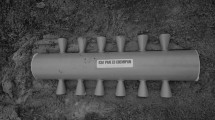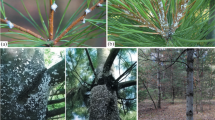Abstract
After the outbreak of Dendrolimus superans Buter in 2002, many insect borers quickly invaded larch (Larix gmelinii Rupr.) forests in the Aershan of Inner Mongolia. Methods involved included setting sample plots, collecting adults in iron traps and measuring areas of galleries to study the invasive sequence, their ecological niche and the extent of the different effects by the main insect borers to their hosts. The results showed that the damage of D. superans weakened L. gmelinii, first Ips subelongatus Motschulsky invaded, followed by Acanthocinus carinulatus Gebler, Monochamus urussovi Fisher and M. sutor L. After the outbreak of D. superans, the average density of longhorn beetles per L. gmelinii tree increased. The ecological niche of Ips subelongatus stretches almost from the base to the top of the trunk. The number of insects in older stands of L. gmelinii is larger than those in middle aged stands. They do not damage healthy trees of L. gmelinii. The ecological niche of A. carinulatus is higher in dead L. gmelinii trees than in weak ones. The degree of damage is directly proportional with age and depth of bark. M. urussovi mainly damages trunks below 4 m in weak trees; in dead trees they can do damage up to 6 m in height. M. sutor mainly damages trunks below 5 m in weak L. gmelinii trees; in dead trees they cause damage up to 7 m. Again, the degree of damage is directly proportional with age. None of the three species of longhorn beetles damage healthy L. gmelinii and younger trees. Among the main insect borers, the degree of damage caused by I. subelongatus is more serious than that of other insects.
Similar content being viewed by others
References
Baranchikov Y N, Kirichenko N I. 2002. Feeding and growth of the Siberian moth Dendrolimus superans sibiricus (Lepidoptera, Lasiocampidae) larvae during summer diapause. Zoologicheskii Zhurnal, 81(11): 1,345–1,349
Cai H. 1997. Life habit and control technology of Dendrolimus superans Butler. IM For Sci Tech, Suppl.: 99–100 (in Chinese)
Coulson R N, Mayyasi A M, Foltz J L, Hain F P, Martin W C. 1976. Resource utilization by the southern pine beetle Dendroctonus frontalis (Coleoptera: Scolytidae). Can Entomol, 108: 353–362
Coulson R N, Pope D N, Gagne J A, Fargo W S, Pulley P E, Edson L J, Wagner T L. 1980. Impact of foraging by Monochamus titillator (Col.: Cerambycidae) on within-tree populations of Dendroctonus frontalis (Col.: Scolytidae). Entomophaga, 25:155–170
Deng G, He C X, Wang Y J, Zhang W L, Song X Q, Meng F Z. 2002. Using Luseweilei insecticide to control Dendrolimus superans. J For Res, 13(2): 162–163
Flamm R O, Coulson R N, Beckley P, Pulley P E, Wagner T L. 1989. Maintenance of a phloem-inhabiting guild. Environ Entomol, 18: 381–387
Galkin G I. 1975. Outbreaks of Dendrolimus sibiricus and solar activity. Lesnoe Khozyaistvo, 8: 83–85
Galkin G I. 1993. Biology of Dendrolimus superans sibiricus in Evenkia. Zoologicheskii Zhurnal, 72: 142–146
Kharuk V I, Ranson K J, Kozuhovskaya A G, Kondakov Y P, Pestunov I A. 2004. NOAA/AVHRR satellite detection of Siberian silkmoth outbreaks in eastern Siberia. Int J Remote Sens, 25(24): 5,543–5,555
Li L, Meng H W, Sun X. 2002. Bionomics of Dendrolimus superans Butler. J IM Agric Univ, 23(1): 101–103 (in Chinese with English abstract)
Li X L. 2006. Using smoke insecticide to control Dendrolimus superans. For Xinjiang, 1: 44 (in Chinese)
Liu K Y. 1994. Causes of outbreak of the larch caterpillar (Dendrolimus superans Butler) in Da Xingan mountain and its control strategy. J Northeast For Univ, 1:34–40 (in Chinese with English abstract)
Wang Z H, Chai M, Wang S J. 1999. Occurrence characteristics and regulation of Dendrolimus superans Butler. For Sci Tech, 24(1): 34–35 (in Chinese)
Xiao P. 2004. Aerial control against Dendrolimus superans Butler and its influence on natural enemies. For Pest Dis, 23(2): 18–20 (in Chinese with English abstract)
Yu C M, Guo S P, Cheng D J. 1984. Study on the occurrence regulation of Ips subelongatus in man-made forest. J Northeast For Inst, 12(2): 27–39 (in Chinese)
Zhang J S, Hao L. 2002. Occurrence of Dendrolimus superans in Daxing’anling of Inner Mongolia and its management. For Sci Tech, 27(2): 26–28 (in Chinese)
Author information
Authors and Affiliations
Corresponding author
Rights and permissions
About this article
Cite this article
Yuan, F., Luo, Yq., Shi, J. et al. Invasive sequence and ecological niche of main insect borers of Larix gmelinii forest in Aershan, Inner Mongolia. For. Stud. China 10, 9–13 (2008). https://doi.org/10.1007/s11632-008-0014-x
Received:
Accepted:
Published:
Issue Date:
DOI: https://doi.org/10.1007/s11632-008-0014-x




